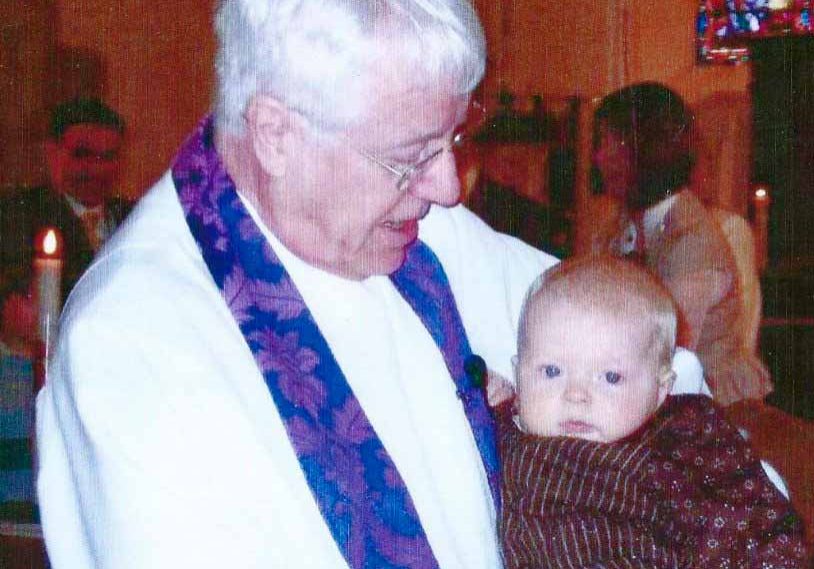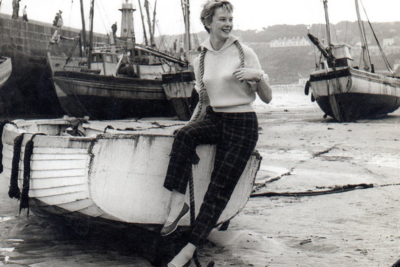
Anyone for Church? Priestly Brook
by Northern Life
The Reverend Priestly Brook, an Anglican priest, retired in August 2012 from the Colne and Villages Team Ministry in East Lancashire. His Bishop has granted him a licence with ‘Permission to Officiate’. He is married to Christine, with six grown up children. For many years he’s been a well-known preacher and communicator in the North of England.
I really did not have much chance in life! For when I was tidying up my mum’s affairs, I was thrilled to bits to see in a chocolate box with papers and photos, a form that my mum must have taken from the hospital’s maternity ward with details of my birth back in August 1942. But I was rather taken aback when I looked at the bottom of the form marked ‘Doctor’s Comments’ and it simply read: ‘poor sucker’!
Well that could hardly be said of the life of a Church of England vicar in Victorian times who was possibly envied. Often he was absent from his living, with a curate in place to whom he paid a nominal sum and at the same time drew the parish living which in some cases was very attractive! If in parish, he would live in his vicarage, usually the second largest property after the Lord of the Manor’s, with several servants to care for his needs.
He would have studied at one of the colleges, and would be considered academic as well as respected by his parishioners for his standing in the community. Even though they would rarely meet him socially since he would socialise with his own class, parishioners would attend his church to worship the God whom they adored or feared or out of a sense of duty.
Yet in many villages and towns the free churches such as the Methodist, ultimately of many strands; the Baptist and Congregational had been established, churches being built and the number attending growing rapidly, often at a loss to the Church of England. The families of the working community found that the worship and social life more conducive to their life style. While the Church of England still held the largest membership, with the Roman Catholics second, there was a significant membership of these individual free churches, creating for the first time a
truly multi-denominational nation with much rivalry evident.
Alongside this there was a need for education, particularly of the young. Sunday schools were founded in most of the free and established churches to offer very basic or elementary education.
Yet this was to change when by the late 19th century the education of children became compulsory and the Church of England, the Roman Catholic and to a lesser extent the Methodist church adapted the use of existing buildings, or built new schools for the purpose of weekday lessons.
Thereafter, the Sunday schools attracted children each week purely for worship and the teaching of religious education usually in age-related classes. Consider this; prior to the First World War half of all our nation’s children attended Sunday school each week, taught by hundreds of thousands of teachers, including many young women.
The First World War was to change much in society including Church and Sunday school attendance. And while there was a sense of deliverance in winning the conflict and patriotic pride, this dissipated in the ensuing years with attendance falling and revived in the second conflict, till in the fifties and sixties it offered a new world and a change in religious and social order!
Gradually our country moved on and fewer attended Church or Sunday school, and even though there was a revival following the Billy Graham campaigns, Sundays for the majority were taken up with other callings, such as the freedom which the motor car offered to set off for the day, sport and recreation on the Sabbath, jobs around the house including washing on a Sunday, all unthinkable a couple of decades before, in fact anything but worshipping in church, save for funerals, weddings and baptisms.
Today, the truth is there have never been as many Christian denominations and so few churches! Just like the recent trend in the closure of public houses, for much longer churches have closed through lack of attendance or rationalisation, then have been demolished or turned into secular use, both in our towns and country.
Some individual churches appear to have large followings, often Anglo-Catholic or by contrast the evangelical or charismatic churches, the churches for the cities’ young affluent and those who attract the immigrant population alongside the more recent Pentecostal and American churches.
So where does this leave the typical middle of the road long-established denominational church, who represent the greatest number of places of worship? Certainly, weekly church and Sunday school attendances of these churches have continued to fall over the decades, alongside the dramatic fall of the much higher percentage of those who indicate they are Christians on the census return.
Most traditional denominations including the Church of England and the Roman Catholic Church have experienced a significant decline in those called and training for priesthood. In the Church of England many of those serving are often unpaid and part-time, and despite the introduction of, and the subsequent significant increase in recent years of priests who are female, overall the numbers are much lower than a few decades ago.
Today not only will he or she have charge of several churches, and prepare for and preside at worship and celebrate communion, but an expectation to be involved with others in church activities, often chaplain to the schools, with governorship and appeals panels, to nursing homes, hospitals and prisons and to serve on community committees and attend civic occasions, alongside funerals, weddings and baptisms often for those who do not attend church regularly.
The extraordinary commitment each day by the priest as he or she serves the church and the community may be rewarding, but is certainly demanding and in some cases results in exhaustion.
But who actually attends the Church of England any more? It is said their congregations are elderly, middle class and white and their numbers few! But is this true?
Well, since it is the established church, everyone living in the parish has the right to a service of baptism, marriage or funeral, and many exercise that right, and if so these services are generally attended by family and friends rather than the regular congregation.
Church attendance of 800,000 in a week is now half that of 1968, or a quarter compared to 1930.
Today, the majority of those who worship regularly are aged 50-plus with a third of all who attend over 70, with just 20 per cent under 18 years of age and overall two-thirds are female. The Church of England has 12,500 parishes with 15,800 churches, an enormous responsibility and expense for such modest congregations representing just two per cent of the nation’s population.
Few churches would survive financially from the regular giving of those who worship, so most hold fundraising events in an attempt to be financially secure, with a growing minority unable to do so.
Admittedly, while numbers are much less than a few decades ago, many church members, in addition to corporate worship, do participate in Bible study, fellowship and are involved in a multitude of church-based groups and events while the young enjoy Sunday school and uniformed organisations. And against the national trend some churches are actually growing numerically and spiritually and I suspect maybe the catalyst for others to follow.
Some predict the church is dying, but this is just not true, which humorously reminds me of my fellow priest who is into everything electronic and uses his smart phone as a pocket-sized sat-nav wherever he goes. So when he had to drive to a distant crematorium that he was unfamiliar with, he fed in the details for the route. Unfortunately he got caught up in heavy traffic and arrived just in time, threw on his vestments and dashed to lead the procession, and as the Coffin was being placed on the catafalque, his sat-nav declared ‘You have now reached your destination!’
Destination wise, the church certainly helps those who believe, to reach heaven! But here on earth the church is on an active journey, and no more so than when it comes to serving the community.
There are approximately one million children currently attending one of 4,500 Church of England primary schools and two hundred secondary schools while historically 15 million adults alive today went to one of these schools. Each week the clergy of the Church of England baptise around 2,500 children and adults; marry nearly 1,000 couples, one in five of all marriages; and officiate at 3,000 funerals, one in three of all funerals. The significant majority of these who are served by these occasional offices are not regular in their attendance at church worship.
While we must never ignore the contribution to society of all faiths and none, a significant number of church members who are in paid employment are serving the community from teachers to social workers, prison officers to hospital staff and in many other vocations, while alongside the clergy more than 80,000 church members do voluntary work to support children, young people and families.
In addition, the vast majority of church members give of their time and finance to support not just the church but many charities and organisations, and while often overlooked they pastorally serve hundreds of thousands of individuals. This is a significant commitment to be proud of, since altogether church members give many millions of hours to the service of others.
In comparison to a century ago there are far fewer individuals and families worshipping in our churches every Sunday, but its members continue to make a significant contribution to both the life of the church and to society and are following in the footsteps of Jesus who asked that we may love the Lord our God with all our heart, soul, mind and strength and love our neighbour as ourself.








